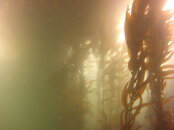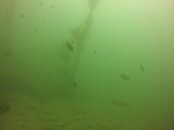You are using an out of date browser. It may not display this or other websites correctly.
You should upgrade or use an alternative browser.
You should upgrade or use an alternative browser.
Devastation of Kelp Forests at Shaw's Cove
- Thread starter HBVetera n2312
- Start date
Please register or login
Welcome to ScubaBoard, the world's largest scuba diving community. Registration is not required to read the forums, but we encourage you to join. Joining has its benefits and enables you to participate in the discussions.
Benefits of registering include
- Ability to post and comment on topics and discussions.
- A Free photo gallery to share your dive photos with the world.
- You can make this box go away
The water has been in the 70s. That will do it.
- Messages
- 5,141
- Reaction score
- 4,137
- # of dives
- 5000 - ∞
@HBVetera n2312
Kelp health is dependent on many factors - water temperature sub striate -ever changing topography - pollution etc
Currently the water is unseasonably warm.
Many years ago the late Dr. Richard Terry, of Anaheim, did his USC doctorate on Kelp along the California coast
He reviewed maps and charts (Maps are for land Charts are for water) dating back to the 16th century. He discovered that kelp was very erratic in growth patterns and transitional in locations.
As a relative new diver you might want to google Dr. Terry -- He is the only American to have a Sea Mont named in his honor in the Challenger deep of the Marianas trench-- and from Anaheim California !
SDM
Kelp health is dependent on many factors - water temperature sub striate -ever changing topography - pollution etc
Currently the water is unseasonably warm.
Many years ago the late Dr. Richard Terry, of Anaheim, did his USC doctorate on Kelp along the California coast
He reviewed maps and charts (Maps are for land Charts are for water) dating back to the 16th century. He discovered that kelp was very erratic in growth patterns and transitional in locations.
As a relative new diver you might want to google Dr. Terry -- He is the only American to have a Sea Mont named in his honor in the Challenger deep of the Marianas trench-- and from Anaheim California !
SDM
Temperatures above about 68° F for a period of about two weeks will cause giant kelp (Macrocystis) to be unable to metabolize properly and die off. Certainly other factors like rocky substrate being covered by sand or nutrient depletion also play a role. I did my Ph.D. research on shifting patterns of giant kelp around Catalina Island back in the 90s and there are other factors as well. See http://www.starthrower.org/research/kelpgis/ijmargeo.htm
We are seeing die-offs here on the island but mostly in the upper water column where temps have been in the low- to mid-70s for some time. Below the thermocline where temps are in the upper 50s to lower 60s, kelp is doing better.
We are seeing die-offs here on the island but mostly in the upper water column where temps have been in the low- to mid-70s for some time. Below the thermocline where temps are in the upper 50s to lower 60s, kelp is doing better.
HBVetera n2312
Contributor
Makes sense. My computer showed 65 degrees in June and 59 degrees on September 1. Nothing to say what the temps where in between my measurements, which were taken at approximately 40 fsw during the morning hours. I was just shocked at the amount of loss.
Great information, thanks again for the replies.
Great information, thanks again for the replies.
Similar threads
- Replies
- 3
- Views
- 1,558
- Replies
- 30
- Views
- 4,779
- Replies
- 39
- Views
- 5,674
Trip Report
Red Sea Serpent Grand Egypt
- Replies
- 41
- Views
- 5,005






